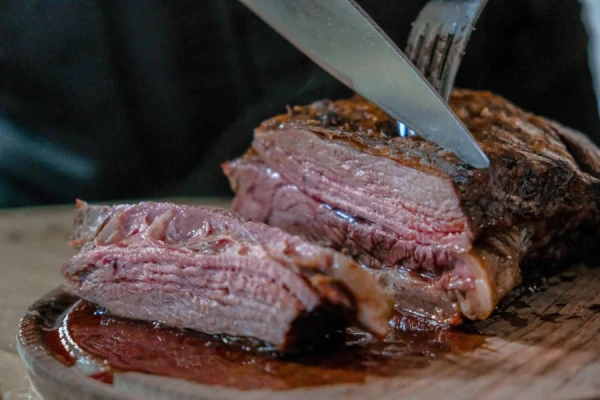
Every chef knows how difficult it is to catch the moment of perfect meat doneness. If you overcook it a little — it becomes dry and tasteless, and if you take it out a bit earlier — there is a risk of food poisoning. We will tell you how to learn to determine the readiness of meat without using a culinary thermometer.
Chicken
To check if the chicken is ready when roasting it whole on a grill or in a pan, pierce it with a cooking needle, fork, or toothpick in the breast and thigh areas. These spots have thicker muscle tissue and take longer to cook. If the fork goes in easily and clear juice comes out of the puncture instead of blood — the chicken is ready.
When roasting poultry in the oven, cooking time can be calculated by multiplying the weight of the carcass by 40. This means that to fully cook one kilogram of chicken at a temperature of 180–200 degrees Celsius, it will take at least 40 minutes.
Wings and legs cook significantly faster than the breast. To prevent them from burning during roasting, tie them to the carcass with thread or twine. Wrap the exposed bones on the legs with foil.
The boiling time for chicken depends on the age of the bird. Young chicks cook significantly faster (from one to one and a half hours), while an old chicken requires boiling for at least 2–2.5 hours. The meat is considered ready when it starts to easily separate from the bones but does not fall apart at the slightest touch — this indicates that you have overcooked the chicken.
Kebabs
On average, it takes 25–35 minutes to cook kebabs. While lamb and beef can be tasted even when slightly undercooked, pork and chicken must be cooked all the way through.
It is impossible to ensure the meat is ready on the grill without cutting it. The heat from the coals is distributed unevenly (unlike frying in a pan or roasting in the oven), and there is always a risk of taking off half-raw pieces when grilling kebabs.
Cooks usually check the meat from the edges of the skewer — these areas tend to be less cooked. Make a shallow cut with a knife and pierce the meat piece halfway through with a toothpick. If the kebab feels soft to the touch, is red inside, but has a crispy crust — you put the skewers on the grill too early; the meat burns on the outside but remains raw inside.
When the meat feels firm to the touch, clear, pink juice is released, and the edges of the piece are dark — the kebab is almost ready and needs to “rest” for 5–10 minutes on residual heat. If the piece is firm to the touch, evenly cooked, and the juice is clear and transparent — the meat is ready and can be served.
Rabbit
Rabbit meat does not like quick frying. However, during boiling and stewing with spices and vegetables, tender rabbit meat reveals its full flavor and aroma. There are several ways to determine the readiness of the meat depending on the chosen cooking method.
In a pot, a rabbit carcass cut into small pieces is boiled for about 35–40 minutes. This time is sufficient for the meat to become tender and easily pierced with a fork.
Stewed meat will be ready in one to one and a half hours. After this time, it should be tender and easily separate from the bones.
When cooking in a slow cooker on the “Stew” setting, the rabbit will take at least two hours to cook. After this time, the meat should not have any foreign odors, and it should be juicy and tender to the touch.













